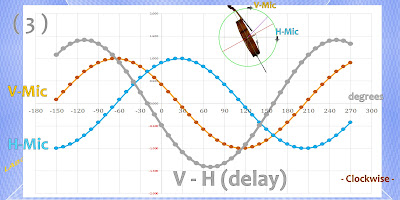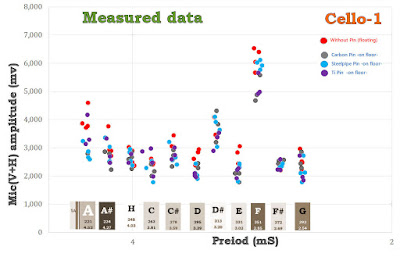[ 12/26/2019 ] Labels: 70.Resonance Direction
Resonance directions on cello were briefly measured at A-G chromatic semitones on A-string and also D-C semitones on D-string comparing with 'steel pipe endpin 300mmL on floor' and 'without endpin', down-bowing and up-bowing.
(1)The results can be divided into two groups; [group-a]stable, clear tendency in resonance direction, [b]diverse, taking various resonance directions. The reason of [b] is not enough clear now, probably because of the factors such as multi phases even during the target semitone, difficulties in judgement of delay/waveform, complexity, vulnerability, interruptions by external effects. Differences between down-bowing and up-bowing were unclear either.
(2)According to the frequency transition, as a long-tern viewpoint, the resonance direction seems rotating. The angle rather drifts near around 0 degree on D string, however unlikely D, the angle seems spreading/rotating wide-angle on A string.
(3)There might be a possibility that an endpin narrows down the angle range of resonance. These results might reek us a secret of the body of violin-family instruments that has been probably designed originally as being able to resonate for all-round directions.
Resonance direction measurements will be gone on by switching the examinee-instrument to CELLO-1.
Cello-2(115歳・ドイツ製)について、スチールパイプエンドピン300mmL(床置)とエンドピン無(スタンド置)で、各々ダウンボーイングとアップボーイングにて、A線及びD線上の各半音ごとの振動の方向を計測した。測定データ数は十分とは言い難いが、次の傾向が見られた。
(1)安定して独自の振動方向を示す音グループ[a]と、多様な方向を示す音グループ[b]の2グループに分かれた。
[a]は、A線上では H C# D# E F#、D線上では E F F# G G# A# であり、
[b]は、A線上では A D F G、D線上では D D# H であった。多様な方向を示す理由は、今後さらに調べる予定であるが、例えば、一つの半音域の中に多様な振動形態を持つ・位相の計算が難しい(判別しにくい)・振動波形が交錯したりつぶれたりしている・何某かの外的影響を受けやすい、などが考えられる。ダウン/アップボーイングで違いが見られるのは[b]グループである。
(2)大きく見ると、周波数の変化とともに振動方向が回転(ローテート)しているように見える。D線域では胴体の輪切り方向(=低角度)に振動することが多く回転周期も長いが、一方 A線域では 激しく変化しているように見える。
(3)エンドピン有り/無しで比較するとエンドピン無しの場合の方がわずかではあるが、多様な振動方向を取っているようにも感じられる。バイオリン属の胴体の形状・構造はそもそも多様な振動・共鳴を取りうるように設計されているのかもしれない。
次の投稿では、Cello-1を使ってもう少し多くのデータを調べてみる。























































